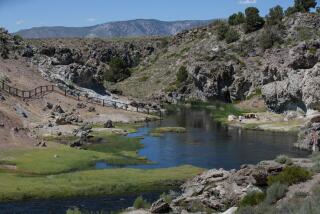Volcano discovery hints at fire below ice in Antarctica
A volcano may be stirring more than a half-mile beneath a major ice sheet in Antarctica, raising the possibility of faster base melting that could ultimately affect climate.
Seismologists working in a mountainous area of Marie Byrd Land in western Antarctica detected a swarm of low-magnitude earthquakes in 2010 and 2011 similar to those that can precede volcanic eruptions, according to a study published online Sunday in Nature Geoscience.
The area of activity lies close to the youngest in a chain of volcanoes that formed over several million years, and the characteristics and depth of the seismic events are consistent with those found in volcanic areas of Alaska’s Aleutian Islands, the Pacific Northest, Hawaii and Mt. Pinatubo in the Philippines, the study concludes.
The tight focus of the 1,370 tremors and their deep, long-period waves helped researchers rule out ice quakes, glacial motion or tectonic activity as causes. So, too, did their apparent depth: At 15-25 miles beneath the sub-glacial surface, they are close to the local boundary between Earth’s crust and mantle.
“At first I had no idea it was something volcanic, and then, as I started putting together all the pieces, it started looking more and more like I’d found a volcano,” said study coauthor Amanda Lough, a seismology graduate student at Washington University in St. Louis.
Chances of a massive fire-and-ice catastrophe are slim, however. Clusters with these wave characteristics have sometimes preceded eruptions, but not always, Lough said. And it would take a staggering release of energy to punch through more a half-mile of ice, she noted.
“Does this mean that something is going to be happening in the next 20 years or so? I have no idea,” she said. “It’s not something that’s going to cause major issues. You’d have to have a huge, huge eruption.”
Still, even a small eruption could increase base melting and lubricate the ice sheet. “If you have a future eruption it’s going to increase the heat flow, so you’re going to have more melting in the surrounding area, which will then lead to more water at the base of the ice sheet and cause the overlying ice flow to increase in velocity because it’s been lubricated.”
How such melting could affect the vast ice sheet remains unknown.
The data came from seismic equipment used to study the interaction of ice with the crust in Antarctica, part of a broader program studying polar ice caps. That data were collected in 2010-2011, but most of the events analyzed occurred in two swarms during the first two months of 2010 and in March 2011.
Radar imaging also revealed a buried ash layer believed to be from an eruption of Mt. Waesche about 8,000 years ago. There also is evidence of small flows of magma on the sub-ice topography, and the surface closest to the swarm appears to be a mound of volcanic material, according to the study.
Lough, who expects to complete her PhD work next year, has been bowled over by reaction to the discovery. “This is my first paper and people keep calling me wanting to know about it,” she said. “This is going to be one of the chapters in my thesis -- probably the most exciting one.”
The study was led by geophysicist and seismologist Douglas Wiens of Washington University, who is supervising Lough’s thesis. Other research team members hailed from UC Santa Cruz, Penn State University, New Mexico Tech, Colorado State University, the University of Texas at Austin, Central Washington University and Ohio State.







